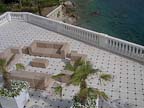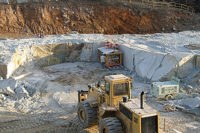

It was obvious why the spot for the mansion was chosen. It sits on the edge of a small peninsula which guarantees intimacy and safety, along with spectacular views of the Mediterranean. Recently, the property was sold to an English group, which decided to remodel the estate. However, to ensure that the historical feel of the home would not be compromised, the design exclusively relies on the use of “noble materials†-- including a range of natural stone -- while at the same time includes some contemporary touches which matched perfectly as a whole.
To execute the stonework, the firm of Marbrerie Azureenne was hired as the stone setter. With more than 250 workers, Marbrerie Azureenne specializes in projects of this type, however, its stoneworking shop did not have the capacity for the intricate pieces required for the project.
Marbrerie Azureenne contacted Arriaga, a Spanish company that it had worked with in the past on projects of this type. Arriaga's process combines modern technology with a special group of stone craftsmen to give the right finishes to the pieces.
Also important was that all of the stone materials used came from Arriaga's own quarries, and the materials were processed in Arriaga's second factory. The factory is highly sophisticated and computerized for the transformation of marble blocks into slabs, tile and moldings. Along with the crafted materials, more than 65,000 square feet of tile were used.
“All of the stone materials used are those en vogue, reflecting the present tendencies,†said Kai Niepel of Arriaga. “Cream tones mixed with whites with a touch of a different color. The selected materials were mostly marble -- Crema Arriaga, Caliza Ramage, Caliza Capri, White Macael and various accent pieces in black, green and red.â€
The design of the mansion makes for extensive use of exterior space to provide for stunning views of the Mediterranean. All of the expansive terraces are surrounded by a remarkable total of 440 crafted balusters.
The interior also includes extensive use of stone -- as flooring as well as a range of architectural pieces. “The architect was sure to make use of all of our fabrication expertise,†said Niepel.
As evidence of this, there are three different fireplaces, all of which were fabricated in Louis XVI and Regencia style, according to authentic old models. After a rigorous selection of materials, which concluded with the selection of White Statuario marble, Arriaga's craftsmen were able to meet the architect's requirements.
The main entrance and hall feature marble columns, setting the architectural tone of the mansion. White Macael marble was selected for the columns because of its hardness with low porosity, while the honed finish gives the columns the appearance of a soft white.
The honed finish continues throughout most of the interior, but most of the exterior surfaces were sanded or aged, in order to make them slip resistant.
Caliza Ramage, one of Arriaga's exclusive materials, was used for all interior steps -- a total of six floors. “It has a more warm aspect that contrasts with the classic polished marble,†said Niepel.
